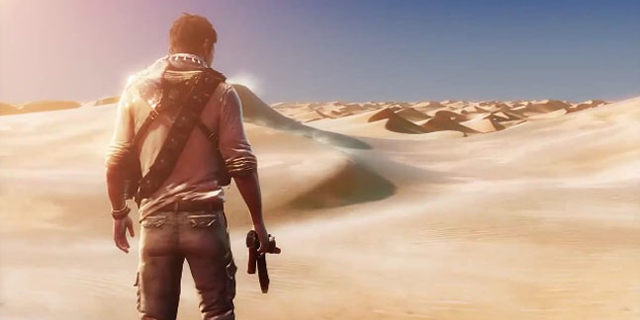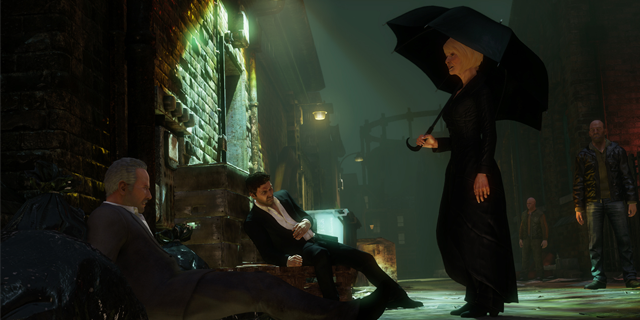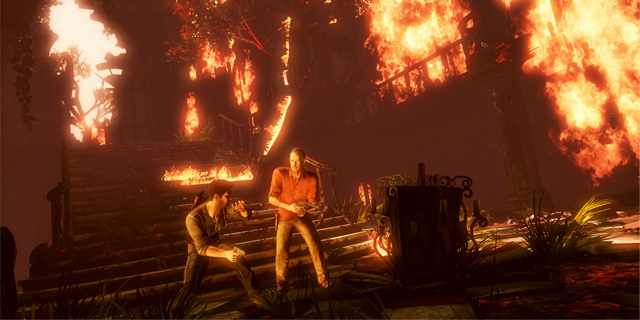
Every gamer has their reasons for enjoying the medium of video games. We’ve always been drawn to games as a narrative experience. Sometimes you get so enraptured in a game that you won’t even notice what’s wrong with it mechanically. Then, when you’re halfway through a game and enjoying the heck out of it, someone says something like, “Doesn’t the combat get a little repetitive?” Then the glass shatters in your head and you realize that yeah, it does get a little repetitive. And that climbing the terrain was annoying. And that the gunplay is a little off. Uncharted 3: Drake’s Deception could have been one of those games, but it isn’t at all.
One common criticism about this game, and the series in general, is the player being confused about the environment. Often, which ledge to jump to next can be confused with a part of the background, leading to Drake plummeting to his doom. We actually love this about the game. When Drake had to find an artifact in a room full of old trinkets and bric-a-brac, finding it made us feel accomplished. We weren’t just looking for the glowing thing. There were Jason Bourne-style rooftop chases, where we didn’t know what to do next. At points we had to just slow down and stand there for a while to figure out which way to jump. This not only made the situation feel more real, but all the more pressing. We needed to make a snap decision: sometimes it was right, while other times it was very wrong.
That brings us to our main criticism: the reality of the game is very easily broken. If there’s one thing Naughty Dog has done better than anyone else with this series, it’s immersion. No game has ever really made the player feel like a part of this big blockbuster film plot than Uncharted, but that immersion is very easily shattered. When running from agents in a rooftop parkour chase scene, the momentum grinds to a halt when you die. Your heart instantly stops racing, and you realize that you’re playing a game when a heavily scripted moment slams on the brakes so you can respawn. And there’s also the thought that’s hung over the entire series: that Drake is basically a mass-murdering sociopath. He’ll mow down hundreds of bad guys within minutes, and follow it up with a snarky comment. The audience is supposed to see him as a roguish n’er-do-well, but he kind of just comes off as psychotic. We were delighted to see this actually addressed in the story.
The Drake conundrum is one akin to Batman. Though painted as a human character, their real flaws are what shine through when you start seeing them as human. Drake is meant to be seen as an everyman hero, who fights for what’s right til the end and gets through by the skin of his teeth. But when you really look at it in the context of the game, he’s not such a nice guy. In every game he’s used and taken advantage of his friends for his own means, much like Batman tends to with his sidekick collection. For a loner, Batman sure puts a lot of people in danger to help his own cause.
Same goes for Drake. In the first game he used Elena to find a lost artifact of Sir Francis Drake’s. This not only lead a group of pirates directly to them, but almost got both of them killed over and over. In Uncharted 2, he seemed to have learned some lesson from this and decided to turn down Flynn’s offer to look for Marco Polo’s lost gold, but is swayed very quickly when he gets a glint of treasure in his eye. Both situations were solved by murdering thousands of people followed by one-liners. We fans of the series have turned a blind eye to Drake’s selfishness and chalked it up to his Han Solo-esque nature. But you can’t ignore that for three games.
Drake’s selfish actions lead each of his friends to almost die, and not just in the game way. They even make a direct reference to where Elena had disappeared to between sequels, and it was fairly obvious why she’d left. Seeing Drake get knocked around because of his own pigheadedness made him feel like less of the aw-shucks Indiana Jones kind of hero and more like a Dirty Harry or a Guy Ritchie protagonist. Which is fitting for the game’s opening setting and cast of characters.
New additions to the cast like Drake’s well-read actor buddy Charlie and Hellen Mirren-esque villain Catherine fill out the game’s roster with well-written dialogue and genuine character relationships, but even the minor characters are loaded with personality. There’s one guy in particular who we see for literally 45 seconds. He confronts young Drake on a rooftop and is dispatched by Sully before he can speak two lines, but based on the way he carried himself and his design, we wanted to know everything about him. This is what Naughty Dog has done better than anyone else this generation. By getting actors who know how to emote aurally as well as physically and filling their mouths with decent dialogue recorded simultaneously with the mo-cap, they’ve created characters we care about, and not just because they do cool superhuman things.
The aiming is a little bit slippery, and the scenarios can be a bit ridiculous. Often we found ourselves just dumped into an enormous room, filled with dudes who would come at us from every angle all at once. But all we could think when playing those segments was this: this room is huge. The environments are wonderfully-designed and feel like living breathing parts of the world. When we expected load times, Drake just naturally sauntered into a new area. We’d move through doors and find new areas without so much as a loading screen or a drop in framerate. Through the rendering of the environments and the weaving of each chapter into the next, Uncharted creates a seamless experience. We could never find a good time to turn the console off, because it’s way too easy to become swept up into the pacing of the game. And it’s easy because Uncharted makes sure you move at its pace.
There are things you need to get done, and the game is making sure you do them. If you’re not moving to the next area quick enough, the game will tell you by annoying you with clues or letting more enemies loose to get you on the move. Like many action games today, Uncharted is all about giving you the illusion that you’re in control, and boy, is it good at it. Even though we could see the strings every time, seeing Drake do something rad like slam a guy into a bar and smash a beer bottle over his head feels cool just knowing that we had some small part in it. Even though all we did was hit a button when the game told us to.
Uncharted 3‘s faults are few and minuscule. When looked at next to its strengths, they all but disappear. We’d say we can’t remember the last timewe felt this engrossed in a title and actually cared about where the story was going, but we can: it was Uncharted 2. Few things are new, but the old things are certainly bigger. Much, much bigger.
Pros: Wonderfully scripted and engrossing story, set pieces that put Michael Bay to shame
Cons: Slightly loose aiming mechanics, heavy scripting that may throw some people off





















